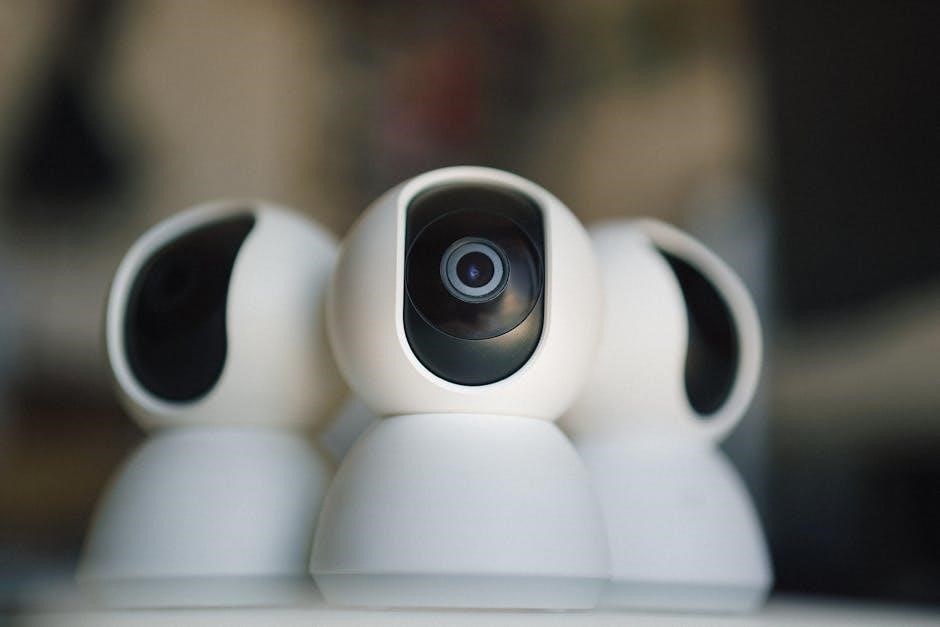The System Sensor D4120 is a high-performance duct smoke detector designed for accurate fire detection in HVAC systems․ It offers reliability, ease of installation, and compliance with fire safety standards․ This manual provides essential guidance for proper setup, operation, and maintenance to ensure optimal performance and safety․
1․1 Overview of the Device
The System Sensor D4120 is a duct smoke detector designed for use in HVAC systems, ensuring early fire detection to prevent damage․ It features a photoelectric sensor for reliable performance and is suitable for installation in ducts of various sizes․ The device is built to meet fire safety standards and offers remote testing capabilities for convenience․ Its compact design allows for seamless integration into existing systems․
1․2 Importance of the Manual
This manual is crucial for understanding the System Sensor D4120’s features, installation, and maintenance․ It ensures proper setup and operation, maximizing safety and performance․ The guide provides troubleshooting tips and compliance information, helping users address issues promptly․ By following the manual, users can optimize the detector’s functionality and ensure long-term reliability․ It serves as a comprehensive reference for safe and effective use of the device․
Key Features and Technical Specifications
The System Sensor D4120 features advanced photoelectric technology for precise smoke detection․ It meets NFPA standards, ensuring reliability and compliance in fire safety applications․ Designed for HVAC systems, it offers durable construction and easy integration, making it a robust solution for commercial and industrial settings․
2․1 Product Specifications
The System Sensor D4120 smoke detector features a photoelectric sensor for accurate smoke detection in ducts․ It operates on 24V AC/DC, with a current draw of 40mA․ The detector includes a built-in test switch and LED indicator for status monitoring․ It is compatible with standard duct sizes and meets NFPA 72 and 90A standards, ensuring reliable performance in fire safety systems․
2․2 Design and Functionality
The System Sensor D4120 is designed with a compact, durable housing suitable for installation in various duct sizes․ It features a photoelectric smoke-sensing chamber for precise detection and a built-in test switch for easy maintenance․ The detector includes an LED indicator for visual status confirmation and operates on low power consumption, ensuring efficient performance while meeting fire safety regulations․
Installation and Setup
The System Sensor D4120 installation involves proper placement in duct systems, ensuring compliance with fire safety codes․ Follow the manual for wiring and mounting instructions․ Always leave this manual with the system owner for future reference․
3․1 Pre-Installation Checks
Before installing the System Sensor D4120, ensure all components are included and undamaged․ Verify compatibility with your HVAC system and check local fire safety regulations․ Review the manual thoroughly to understand installation requirements and safety precautions․ Ensure power supply meets specifications and duct conditions are suitable for detector operation․ Proper preparation ensures reliable performance and compliance with standards․
3․2 Step-by-Step Installation Guide
Mount the D4120 detector in the duct, ensuring proper alignment and secure fastening․ Connect the wiring according to the diagram in the manual, observing polarity and voltage requirements․ Install any additional accessories as needed․ Test the detector by simulating smoke conditions and verifying alarm activation․ Perform a final inspection to ensure all connections are secure and the system operates correctly․ Follow all safety guidelines during installation․

Maintenance and Troubleshooting
Regularly clean the D4120 detector to remove dust and debris, ensuring optimal performance․ Refer to the manual for troubleshooting common issues like false alarms or wiring faults․
4․1 Regular Maintenance Tips
To ensure optimal performance, regularly clean the System Sensor D4120 detector by gently vacuuming the sensor and screen․ Check for dust buildup and obstructions in the ductwork․ Inspect all wiring connections to prevent loose contacts․ Replace any worn-out seals or gaskets to maintain proper installation․ Follow the recommended maintenance schedule in the manual for long-term reliability and accuracy․ Always refer to the official guidelines for detailed procedures․
4․2 Common Issues and Solutions
Common issues with the System Sensor D4120 may include false alarms due to dust or debris buildup․ Regular cleaning of the sensor and screen can resolve this․ If the detector fails to activate, check wiring connections and ensure proper installation․ For persistent problems, refer to the troubleshooting section in the manual or contact technical support for assistance․ Always follow manufacturer guidelines to maintain functionality․

Compliance and Certification
The System Sensor D4120 complies with NFPA Standards 72 and 90A, ensuring adherence to fire safety regulations․ It is certified for reliable performance in smoke detection applications․
5․1 Relevant Standards and Regulations
The System Sensor D4120 adheres to NFPA 72 and NFPA 90A standards, ensuring compliance with fire safety and HVAC system requirements․ These regulations outline specific guidelines for smoke detection in duct applications, guaranteeing the device meets rigorous safety and performance criteria․ Compliance with these standards ensures reliable operation and adherence to local fire codes, making it a trusted choice for commercial and industrial settings․
5․2 Certification Details
The System Sensor D4120 is UL and FM certified, ensuring it meets rigorous safety and performance standards․ These certifications confirm the device’s reliability in fire detection systems․ Compliance with these third-party standards guarantees the product’s quality, safety, and adherence to industry requirements, providing users with confidence in its operation and reliability for fire safety applications․

Advanced Configuration Options
The System Sensor D4120 offers customizable settings for enhanced performance, including sensitivity adjustments and alarm threshold configurations․ These options ensure tailored detection capabilities for specific environments and needs․
6․1 Custom Settings and Adjustments
The System Sensor D4120 allows users to fine-tune its sensitivity levels and alarm thresholds through its advanced configuration menu․ These adjustments enable the detector to adapt to various environmental conditions, ensuring accurate fire detection while minimizing false alarms․ Custom settings can be accessed via the device’s interface or through compatible software tools, providing flexibility for different installation scenarios and system requirements․ Regular updates and maintenance are recommended to optimize performance and reliability․
6․2 Integration with Other Systems
The System Sensor D4120 seamlessly integrates with fire alarm control panels, building management systems, and HVAC controllers․ Its compatibility with protocols like BACnet and Modbus ensures smooth communication․ Users can configure the detector to trigger responses across interconnected systems, enhancing overall safety and automation․ Proper integration enables centralized monitoring and control, ensuring efficient operation and reliable fire detection in large-scale installations․

User Manuals and Download Resources
The System Sensor D4120 manual is available online at www․systemsensor․com․ Additional resources, including installation guides and technical specifications, can also be downloaded from this platform․
7․1 Accessing the Manual Online
The System Sensor D4120 manual can be easily accessed online by visiting the official System Sensor website at www․systemsensor․com․ Users can download the PDF version of the manual, which includes detailed installation, operation, and maintenance instructions․ Additional resources, such as technical specifications and troubleshooting guides, are also available for download on the same platform, ensuring comprehensive support for optimal device performance․
Beyond the manual, System Sensor offers supplementary resources to enhance your experience with the D4120․ These include technical bulletins, wiring diagrams, and video tutorials available on their website․ Additionally, the InnovairFlex D4120 Installation Instructions provide in-depth guidance for specific setups․ For further assistance, Fire Alarm Resources hosts free PDF manuals and documents to support troubleshooting and advanced configurations, ensuring comprehensive understanding and maintenance of the device․ The System Sensor D4120 is widely used in commercial and industrial settings for fire safety in HVAC systems․ It’s ideal for detecting smoke in air ducts, ensuring compliance with fire codes, and maintaining indoor air quality․ Common applications include large facilities, hospitals, and shopping malls, where reliable fire detection is critical․ The System Sensor D4120 is commonly installed in large commercial buildings, hospitals, shopping malls, and industrial facilities․ It is typically placed in HVAC ducts to detect smoke and prevent fire spread․ Ideal for areas requiring continuous air quality monitoring, the D4120 ensures compliance with fire safety standards․ Its reliability makes it suitable for high-stakes environments where early smoke detection is critical․ The System Sensor D4120 is widely used in healthcare facilities, shopping malls, and industrial plants․ It is ideal for hospitals due to its precise smoke detection in sensitive areas․ In retail spaces, it ensures safety in large duct systems․ Industrial settings benefit from its durability and reliability in harsh environments․ This device is also commonly installed in schools, data centers, and high-rise offices, meeting specific industry safety requirements․ This section addresses common inquiries about the System Sensor D4120, including installation, troubleshooting, compliance, and proper maintenance․ Refer to the manual for detailed answers and solutions․ Common questions about the System Sensor D4120 include its compatibility with HVAC systems, compliance with fire safety standards, and proper installation techniques․ Users often inquire about accessing the manual online and understanding basic operational features․ Additionally, questions arise regarding maintenance schedules, troubleshooting common issues, and ensuring compliance with NFPA guidelines․ This section provides clear, concise answers to these frequently asked questions․ For technical support regarding the System Sensor D4120, contact their customer service team at www․systemsensor․com/support․ You can also reach them via phone at 1-800-SENSOR-1 or email at support@systemsensor․com․ Office hours are Monday through Friday, 8 AM to 5 PM EST․ For urgent inquiries, refer to the manual or visit their official website for troubleshooting guides and resources․ The System Sensor D4120 is a reliable solution for fire detection, ensuring safety and compliance․ Follow the manual for optimal performance and refer to technical support if needed․ The System Sensor D4120 is a duct smoke detector designed for reliable fire detection in HVAC systems․ It ensures compliance with fire safety standards like NFPA 72 and 90A․ Proper installation, maintenance, and configuration are essential for optimal performance․ Refer to the manual for detailed instructions and troubleshooting guidance․ Regular inspections and adherence to technical specifications ensure safety and functionality․ Additional resources are available online for comprehensive support․ For optimal performance, conduct regular inspections and maintenance as outlined in the manual․ Ensure the detector is clean and free from debris․ Always adhere to manufacturer guidelines for installation and configuration․ Check sensitivity settings periodically to maintain accuracy․ Proper integration with other fire safety systems enhances overall protection․ Refer to the manual for troubleshooting common issues promptly․ Regular updates and compliance with fire safety standards ensure long-term reliability and safety․7․2 Additional Resources and Guides

Common Applications and Use Cases
8․1 Typical Installation Scenarios
8․2 Industry-Specific Applications

Frequently Asked Questions
9․1 General Inquiries
9․2 Technical Support Contacts
10․1 Summary of Key Points
10․2 Final Tips for Optimal Use